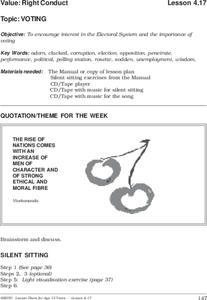Curated OER
Evaluation of Election Process
Students examine the procedures to elect the President of the United States. In groups, they create their own political cartoon presenting a consensus of their point of views on the process. They identify the strengths and weaknesses...
Curated OER
Voting and the U.S. Constitution (Past, Present, and Future)
Students discuss the 26th Amendment, then write letters to a future guest speaker. Students listen to the guest speaker and ask them questions about voting and voter turnout. Students then create handbills urging citizens to vote.
Curated OER
Elections for Elementary Students
Students explore various websites that explain how primaries, caucuses, and general elections function. They view sample ballots, and analyze the executive branch, U.S. presidents, and citizenship.
Curated OER
Candidate Debate; Making Informed Voting Decisions
Pupils study the concept of what it means to be an informed voter who makes conscientious voting decisions based on significant information. In this making informed voting decisions lesson plan, students are introduces to a unit on...
Curated OER
Why Don't People Vote?
Fourth graders conduct an investigation about the subject of voting. They attempt to answer the essential question of, "Why should someone vote in the first place?" The information is used to help students to develop critical thinking...
Curated OER
VOTING
Young scholars discuss 'The importance of voting'. They elect 5 candidates - each representing one of the five values. Each candidate presents a case why their value is important. The other class members then vote for whichever...
Center for Civic Education
Becoming an Informed Voter: Creating Initiatives
Continuing from a previous lesson on how to read and analyze proposed legislation on election ballots, your class members will now practice writing up their own proposals for a new school rule or local ordinance that will be discussed...
Constitutional Rights Foundation
Slavery and the Electoral College
How did slavery mold the creation of the US Constitution? The final lesson in the series focuses on how slavery impacted the creation of the Electoral College. Academics learn how the Electoral College was created because Southern states...
Encyclopedia Britannica
Electoral College Philosophical Chairs Debate
Because of the Electoral College, it is possible to win the popular vote in a US Presidential election and still lose the election. After researching the pros and cons of the Electoral College, class members engage in a structured debate...
School Improvement in Maryland
Demographic Investigation
What are the factors that influence voting patterns? How do these factors influence government funding? Is participation the squeaky wheel gets the grease? Class members interpret graphs and analyze trends to determine what demographic...
Curated OER
How Laws Are Made
Students create a graphic organizer to illustrate the steps elected representatives must take to make a new law. Included: Student work sheet and role-play ideas. Students use their graphic organizers to write a paragraph briefly...
iCivics
Mini-Lesson: Gerrymandering
Who determines the structure of voting districts? The concept of gerrymandering brings to light the ongoing issue of how those running for office gain votes. Hands-on activities enable scholars to analyze the re-drawing of voting...
Curated OER
Take a Stand!
Here is a four-corner debate-style activity specifically geared to election year issues. Learners group themselves according to whether they strongly agree, agree, disagree, or strongly disagree with statements that relate to elections...
Curated OER
Rural Communities Make a Difference
High schoolers research what analysts say influenced Ohio voters in a Presidential election and discuss what that meant in the election, especially in Ohio. Students use provide Internet sources for research.
Curated OER
Closest Presidential Race Ever. . . Or Is It?
Students examine the presidential election of 2000. In this American history lesson, students listen to their instructor lecture on the details of the 2000 election. Students respond to discussion questions and participate in a...
Curated OER
The Electoral Process
Students study the history and mechanics of the Electoral College and formulate opinions as to whether this institution should be preserved, modified or eliminated. They compare and contrast electoral and popular votes in the...
Curated OER
The Class Party
Students take a closer look at presidential elections. In this Electoral College lesson, students participate in a classroom simulation that requires them to form a political party that puts forth a candidate to run for election.
Curated OER
How the Electoral College Works
Pupils research the history and mechanics of the Electoral College and formulate opinions as to whether this institution should be preserved, modified or eliminated. They predict future outcomes of electoral vs. popular votes.
Curated OER
Choose or Lose: The Electoral Process
Learners examine the local and national election process. In groups, they brainstorm a list of the issues important to them and compare them to an overall list of issues present in the election. They analyze graphs and complete...
Curated OER
It's Election Time!
Pupils explore the voting process. They discuss presidential elections, identify the characteristics for what makes the best costume, and participate in a class vote for best class costume.
Curated OER
Elections and Voting
Students discuss political parties by participating in an election and voting process in the classroom. They engage in the citizen responsibilities for electing a government official. Students discuss the history of voting in the...
Curated OER
We the People: A Study in American Voter Turnout: US Government
Learners examine and compare voter turnout in US Elections. They write a letter to a favorite candidate or representative suggesting ways to increase voter turnout.
Curated OER
The Election Is in the House: Was There a Corrupt Bargain?
Students take a stand, supported by evidence, on whether there was a "corrupt bargain" between Henry Clay and John Quincy Adams.
Illustrative Mathematics
Voting for Three, Variation 1
This is an opportunity for young mathematicians to apply reasoning to solve real-world problems with ratios. Even though there are three candidates for class president, students will only consider two at a time, making the first problem...

























